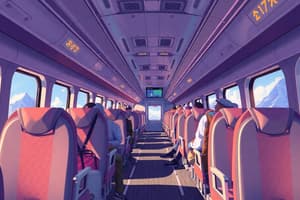Podcast
Questions and Answers
What is the primary function of transportation in the tourism industry?
What is the primary function of transportation in the tourism industry?
- To increase the number of tourists visiting a destination
- To enhance the mass media presence of travel
- To regulate prices for transport services
- To facilitate the movement of goods and people (correct)
Which of the following is NOT an element of the transportation system according to Sharpley?
Which of the following is NOT an element of the transportation system according to Sharpley?
- The Budgeting Process (correct)
- Management and Staff
- The Way
- The Vehicles
How can the quality of transport impact tourism?
How can the quality of transport impact tourism?
- By ensuring safety and convenience for travelers (correct)
- By controlling the marketing strategies of travel agencies
- By influencing government policies on tourism
- By determining the prices of travel packages
What does 'terminal' refer to in the context of transportation?
What does 'terminal' refer to in the context of transportation?
Which mode of transportation is not classified under land transportation?
Which mode of transportation is not classified under land transportation?
What are 'control and communication systems' in transportation primarily used for?
What are 'control and communication systems' in transportation primarily used for?
Which of the following statements about transportation is true?
Which of the following statements about transportation is true?
In relation to transportation, what does 'the way' refer to?
In relation to transportation, what does 'the way' refer to?
What are the IATA three-letter codes for the cities of Manila and Tokyo?
What are the IATA three-letter codes for the cities of Manila and Tokyo?
Explain the significance of IATA in relation to international airfares.
Explain the significance of IATA in relation to international airfares.
What is the format for writing dates according to IATA standards?
What is the format for writing dates according to IATA standards?
How does IATA support travel agencies in ticket issuance?
How does IATA support travel agencies in ticket issuance?
Identify and describe the IATA Traffic Conferences by region.
Identify and describe the IATA Traffic Conferences by region.
What is the difference between the point-to-point model and the hub and spoke model in air transportation?
What is the difference between the point-to-point model and the hub and spoke model in air transportation?
What role does IATA play in the airline industry?
What role does IATA play in the airline industry?
Explain the importance of air transportation in the tourism industry.
Explain the importance of air transportation in the tourism industry.
What are feeder flights, and how do they relate to the hub and spoke model?
What are feeder flights, and how do they relate to the hub and spoke model?
Identify one new trend in the aviation and airline industry.
Identify one new trend in the aviation and airline industry.
Flashcards are hidden until you start studying
Study Notes
Transportation and Tourism
- Transportation refers to the movement of goods or people from one location to another.
- Transportation is essential for the tourism industry because tourism itself involves movement.
- The World Tourism Organization (UNWTO) defines tourism as the movement of people to places outside their usual environment for leisure, business, or other purposes.
- The quality of transportation plays a crucial role in both travel and business.
Different Modes of Transportation
- Land transportation includes cars, buses, trains, and other vehicles that operate on land.
- Water transportation uses boats, ships, and other vessels to move people and goods across water.
- Air transportation involves airplanes and other aircraft that travel through the air.
Importance of Transportation in Tourism
- Transportation is a key component of the travel industry, facilitating the movement of tourists.
Elements of the Transportation System
- According to Sharpley (2006), the transportation system consists of various elements that work together:
- The Way: The path or medium on which transportation occurs. It can be either artificial (roads, railways) or natural (waterways, air).
- The Vehicles: The carrying units that facilitate the movement of people or goods, such as cars, trains, planes, or boats.
- Terminals: Structures, such as airports, train stations, or ports, that serve as points of interchange between different modes of transportation.
- Control and Communication Systems: Systems designed to ensure the safety of passengers and the smooth operation of transportation, such as traffic management, security measures, and communication networks.
- Management and Staff: People who oversee and manage the operations of transportation, ensuring efficient, safe, and reliable services.
Aviation Learning Objectives
- Discuss the history of aviation.
- Explain the importance of air transportation in the tourism industry.
- Identify the categories of air carriers and aircraft.
- Explain the air transport structure.
- Identify the categories of airlines.
- Differentiate domestic and international airlines' services and characteristics.
- Name the new trends in the aviation and airline industry.
- Explain the role and the airport activities.
- Identify the various types of airline ownership.
- Describe the different airport facilities.
Network Planning Models
- Airlines use network planning models to predict their profitability.
- Models are used by airlines for a variety of planning needs including passenger projections, destination analysis, and scheduling decisions.
Network Model Categories
- Point-to-point model: Airlines operate simple routes, focusing on flights between origin and destination cities.
- Hub and spoke model: This model uses larger, busier airports as hubs and smaller regional cities as spokes, feeding passengers to the hub.
Global Industry Associations and Organizations
- Serve as intermediaries and coordinators among member airlines and countries.
International Air Transport Association (IATA)
- Founded by 57 international airlines in 1945.
- By 2020, IATA had 290 members, 480 strategic partners, and 100,000 accredited travel and cargo agencies.
- Mission to represent, lead, and serve the airline industry.
Significance of IATA to Air Transportation
- IATA standardization in the aviation industry.
- Examples include IATA three-letter city codes and airport codes:
- Manila – MNL
- Tokyo – TYO (city), Narita – NRT (airport), Haneda – HND (airport)
- Simplified travel through standardized formatting:
- Name format: Family name/First name (Gamoso/Ryan)
- Date format: Day-Month-Year (September 7, 2024 is 07SEP2024)
- Geographical division: IATA Traffic Conferences divided into three parts:
- North and South America: IATA Traffic Conference 1
- Europe and the Middle East: IATA Traffic Conference 2
- Asia: IATA Traffic Conference 3
Economic Significance of IATA to Air Transportation
- IATA sets gross fares, considered the most expensive fares for international routes.
- Setting the highest fare protects passengers and airlines by ensuring profitability.
- IATA sets a price floor among airlines, protecting both big and small airlines from price drops.
IATA and Travel Agencies
- IATA-accredited travel agencies issue tickets, sell international and domestic tickets, and provide other services.
- Non-IATA travel agencies can purchase international tickets directly from airlines or through IATA-accredited agencies.
International Civil Aviation Organization (ICAO)
- A UN specialized agency established in 1944 by UN member states.
- In 2020, it had 193 member states, including the Philippines.
- Created to administer the Convention on International Civil Aviation (Chicago Convention).
- Responsible for formulating policies for safe, efficient, secure, economically sustainable, and environmentally responsible civil aviation.
Importance of ICAO to Aviation
- Involved in aircraft accident investigations, particularly concerning international airlines.
- Plays a role in environmental protection by addressing issues like air pollution and carbon dioxide emissions.
- Implemented safety measures like door peepholes for pilots in flight decks following the 9/11 attacks.
Philippine Regulatory Bodies
- Civil Aeronautics Board (CAB):
- Ensures the economic well-being of air transportation in the Philippines.
- Promotes fair airfares for domestic airlines.
- Protects airline-riding public through the Air Passenger Bill of Rights.
- Manages air negotiation.
- Civil Aviation Authority of the Philippines (CAAP):
- Oversees the technical and operational aspects of the airline industry.
- Responsible for airport maintenance.
- Conducts aircraft accident investigations.
- Issues licenses for pilots, air traffic controllers, and other aviation personnel.
Studying That Suits You
Use AI to generate personalized quizzes and flashcards to suit your learning preferences.




